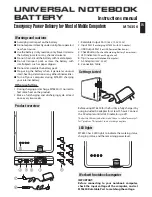
2-9
Rev 2.2, 10/31/94
Sometimes, when you're trying to fit a signal through a transmission channel, it's better to put
processing to work on the lower end of the dynamic range than on the upper end. In other
words, instead of reducing the amount of change at the upper end of the dynamic range with a
compressor or limiter, try using a downward expander to increase the amount of change at the
lower end of the dynamic range.
2.8 Compression
Many times, a signal's dynamic range must be modified to allow it to pass through a
transmission channel without clipping or becoming noisy. Most often, audio engineers patch in
a compressor to restrict the dynamic range of a signal.
A compressor is a gain control device whose output is nearly constant in spite of variations in
its input level. A simple analogy is: you're holding the volume control for a sound system and
you're told to turn it down if the level gets louder than it is now and turn it down enough that
the level is the same as it is now. Figure 2-4 illustrates this concept graphically.
Compressors can also be used
creatively, that is to create an effect. In
this case, the "rules" such as they are,
go out of the window. A large amount of
compression applied to a voice-over can
create the impression of excitement or
intimacy, or simply help make the
signal very loud in a controlled manner,
which might be useful in ensuring that
the voice is
always
heard.
For most voice applications, pick a
moderate ratio (4:1 to 8:1), and set the
threshold low enough to achieve 6 dB
or so of gain reduction. Set the attack
time to retain some of the "edge" of
each word, and set the release time fast
enough to follow the speech. For a
heavily limited sound, set the ratio
higher (10:1 or higher) and use very-
fast release times
3
.
2.9 AGC
The letters AGC stand for Automatic Gain Control. An AGC can also be considered as a special
case of a compressor having a relatively low ratio (1:1 -> 4:1) and a very low threshold level and
a gated release time. Thus, any signal that exceeds the threshold causes some degree of gain
reduction. Additional gain, applied after the compressor, brings the signal level back up to line
level.
Functionally, an AGC works like an invisible (and hopefully inaudible) operator who monitors
the audio level and imperceptibly raises or lowers the gain to maintain the audio level at some
3
Fast attack times may become audible because of the time required to compute the amount of
gain reduction (analog compressors have the same problem, but they usually limit the
minimum attack time so you never have the problem). You can use the 601's compressor look-
ahead parameter to "buy some time" so that the initial overshoot of the signal is controlled by
the compressor. Fast release times cause problems of their own because changes in the gain
reduction may occur during a single cycle of the waveform, causing distortion. Again, analog
compressors are not immune to this problem either.
AUDIO PRECISION
STANDARD COMP/LIM GAIN CURVE
vs
-40.00
-30.00
-20.00
-10.00
0.0
30.000
10.000
40.000
20.000
50.000
Input (dBu)
-40.0
-30.0
-20.0
-10.0
0
10.0
20.0
30.0
10.00
50.0
Output(dBu)
20:1
Ratio
3:1
Ratio
Threshold
Point
Linear
1:1 Ratio
Figure 2-4. Input/Output curves of a compressor.
Содержание 601
Страница 46: ...4 18 Rev 2 2 10 31 94 This page is blank believe it or not ...
Страница 48: ...4 20 Rev 2 2 10 31 94 Notes ...
Страница 50: ...5 2 Rev 2 2 10 31 94 Notes ...
Страница 70: ...7 16 Rev 2 2 10 31 94 Notes ...
Страница 72: ...8 2 Rev 2 2 10 31 94 Notes ...
Страница 74: ...9 2 Rev 2 2 10 31 94 Notes ...
Страница 78: ...11 2 Rev 2 2 10 31 94 Notes ...
Страница 126: ...D 12 Rev 2 2 10 31 94 Notes ...
Страница 138: ...G 8 Rev 2 2 10 31 94 Notes ...
















































